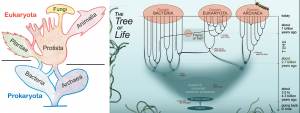An Organismic Approach to Physiology
Physiology, broadly speaking, deals with the scientific study of the processes and mechanisms that underlie the functions of living objects. The term organism in particular, reflects a fundamental property that all living objects possess: organization. This is an important idea, because it allows us to define the organism as a biological entity that has a structure defined by the complex interaction of hierarchically organized components (for more definitions and to spark discussion, see OER: Inanimate Life Chapter 1). The functions in an organism are regulated by intrinsic and extrinsic factors. An example of an intrinsic factor is the genetic endowment of the organism, a program that is responsible for its development, maintenance and demise, as in the organism’s life cycle. Examples of extrinsic factors include biotic and abiotic elements of the environment. Altogether, these environmental factors define the context where the genetic program of the organism is expressed, and importantly, set physical, chemical and biological constraints, or limits for what an organism can actually do.
Activity 1
Read Chapter 1 from Inanimate Life by George M. Briggs.
- What are the four perspectives for defining an organism, according to Briggs?
- Why is it so difficult to define organisms?
The idea of an “organismic” approach to physiology is not new. The terms organismal and organicism have their origin in the early 20th century, at a time when a holistic approach to biology was being introduced. Holism puts emphasis in the wholeness or the integration of systems. To be more precise, a holistic explanatory approach contrasts with a reductionist explanatory approach, in that the latter aims to understand a whole by dissecting it into its components, and again, down to the lowest level of hierarchical organization. However, in a holistic approach the units at higher hierarchical levels are more than the sums of their parts, and as pointed out by Ernst Mayr, it puts emphasis in their relationships. In a holistic point of view, it is recognized that explanatory reduction is incomplete, since new and unpredictable characters emerge at higher levels of complexity in hierarchically organized systems.

As a biology student you are aware that the cell is considered the unit of life. A cell contains a genetic program and its functions are regulated by intrinsic and extrinsic factors. Even though we know viruses and other replicons exist in nature, we do not consider them as building units because we do not have any evidence that they can generate complex structures that go further from their simple aggregation. Indeed, if you think about it, single cells can exist freely in aquatic environments and viruses cannot. Furthermore, under certain conditions and circumstances, individual cells can interact with other cells and build communities. But multicellular organisms are more complex than simple cellular aggregates. Hence, the organismic approach to physiology allows us to stress another key focus of biology, which is the comparative approach. In a most fundamental level, the comparison of single celled to multicellular organisms allows us to explain the complexity of different living objects from the interconnections of cells that have structural, reproductive, energetic and ecological properties that are defined in their genetic programs. Possession of a genetic program also implies a shared history that goes back to the origin of life, and it is the basis to understand the evolution and diversity of organisms.
 Figure 2
Figure 2
Figure 2 illustrates two different classification diagrams that can help you understand the relevance of the comparative approach in biology. In the first chapter we will address the origins of life on earth, the only planet where organisms emerged, as far as we can tell.
References
Goldstein K. The Organism. A holistic approach to biology derived from pathological data in man. American Book Company, New York, 1939.
OER: George M. Briggs. Chapter 1: Organisms. In: Inanimate Life. Milne Open Textbooks. Geneseo.
In memoriam: Josh Wallman, PhD, 1943–2012. Editorial introducing the special issue of Experimental Eye Research in tribute to Josh Wallman. Experimental Eye Research 114 (2013): 1-5.
Mayr, Ernst. Chapter 2: The place of Biology in the sciences and its conceptual structure. In: The Growth of Biological Thought. Diversity, Evolution and Inheritance. The Belknap Press of Harvard University Press, Cambridge, MA, 1982.
Media attributions
Figure 1 contains a picture obtained from the internet
Pending credit to photographer
Figure 2 contains two diagrams obtained from:
Left: Tree of Life © Maulucioni y Doridí, licensed under a CC BY-SA (Attribution Share Alike) license.
Right: New Mexico Natural History Museum Tree of Life
Physiology, broadly speaking, deals with the scientific study of the processes and mechanisms that underlie the functions of living objects.
Intrinsic factors include inherent characteristics of an organism.
Extrinsic factors influence an organism from the outside (environmental factors).